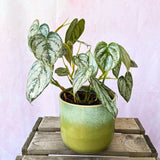-40%
Sold Out
New
Sold Out
New
20 - 25cm Highly Variegated Ficus Belize Rubber Plant 9cm Pot House Plant
House Plant
£24.99
£14.99
The Ficus 'Belize', also known as the Ficus benjamina 'Belize', is a stunning variety of the Weeping Fig, notable for its variegated leaves that showcase a beautiful mix of green, cream, and sometimes pink hues. This ornamental plant is prized for its ability to add a burst of colour and vitality to indoor spaces. Here is a comprehensive care guide to ensure your Ficus 'Belize' thrives.
Light Requirements
- Bright, Indirect Light: The Ficus 'Belize' thrives in bright, indirect sunlight. Position it near a window where it can receive plenty of light but is shielded from the harsh rays of the direct sun, which can scorch its leaves.
Watering
- Consistent Moisture: Keep the soil consistently moist, but not waterlogged. Water the plant thoroughly when the top inch of the soil feels dry to the touch. Reduce watering during the winter months when plant growth naturally slows.
Humidity and Temperature
- High Humidity: Ficus 'Belize' prefers higher humidity levels. Regular misting, a pebble tray with water, or a humidifier can help maintain the humidity around the plant.
- Warm Temperatures: Ideal temperatures range between 18°C to 24°C (65°F to 75°F). Avoid exposing the plant to temperatures below 15°C (59°F), as cold drafts and sudden temperature changes can cause leaf drop.
Soil and Fertilisation
- Well-Draining Soil: Use a well-draining potting mix rich in organic matter. A mix designed for houseplants or a blend of potting soil, peat moss, and perlite works well.
- Fertilisation: Feed your Ficus 'Belize' with a balanced, water-soluble fertilizer every four to six weeks during the growing season (spring and summer). Reduce feeding in the autumn and winter months.
Pruning and Maintenance
- Regular Pruning: Prune in the spring to maintain the desired shape and size. This encourages bushier growth and keeps the plant looking tidy. Always use clean, sharp tools to make cuts.
- Pest and Disease Management: Keep an eye out for common pests such as spider mites, mealybugs, and scale insects. Treat infestations promptly with insecticidal soap or neem oil. Avoid overwatering to prevent root rot.
Repotting
- Periodic Repotting: Repot your Ficus 'Belize' every two to three years or when it becomes root-bound. Choose a pot that is slightly larger than the current one to allow for growth. Repotting is also an excellent opportunity to refresh the soil and check the health of the roots.
Additional Tips
- Leaf Variegation: To maintain the vibrant variegation of its leaves, ensure your Ficus 'Belize' receives adequate light. Insufficient light may cause the leaves to revert to green.
- Acclimatisation: When you first bring your Ficus 'Belize' home, it may drop some leaves as it adjusts to its new environment. This is normal; give it time to acclimate.
Caring for a Ficus 'Belize' involves a balance of proper lighting, watering, and humidity. With attention to its basic needs, this striking plant can be a long-lasting and vibrant addition to your indoor garden.
Our custom made boxes are perfect for transporting your new plants straight from our Yorkshire tropical nursery direct to your door. We use a next day DHL service as standard, allowing plants to be delivered as fast as possible.
Check out our YouTube video to see exactly how we pack for safe delivery.
Check out our YouTube video to see exactly how we pack for safe delivery.
- Plants are supplied in plastic nursery pots unless stated in the product title.
- Plants are not for consumption unless stated as edible.
- Plant heights can fluctuate +/- 10%.
- Our plants are kept at our tropical nursery in Yorkshire where we maintain an average temperature of 18c.


































